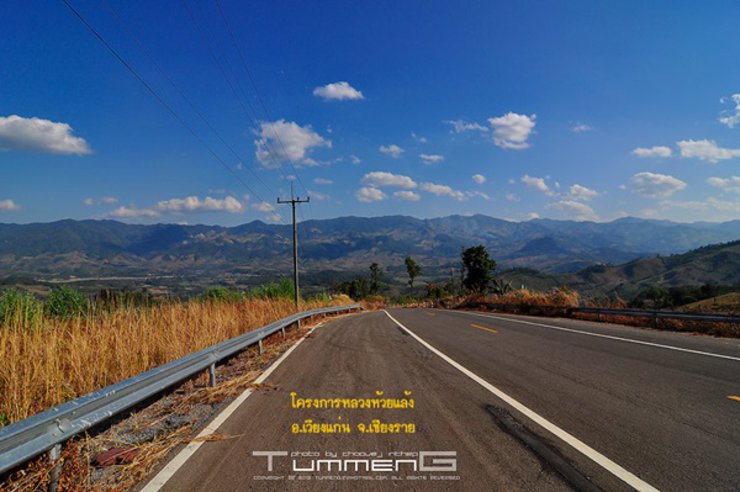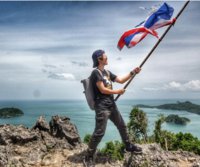

Visit the Huai Laeng Royal Project Development Center and admire the cherry blossoms at the Doi Pha Tang Royal Project.


Five years ago, I decided to leave the capital and return to my hometown in the countryside to help with the family business. Upon my return, I felt lost and unsure of my next steps. A friend, who worked for the district office, suggested I visit the Huay Laeng Royal Project for inspiration. Intrigued, I invited a friend from Bangkok to join me on this exploration.


The journey began shortly after the sun had dipped below the horizon. Our destination was the Huai Laeng Royal Project Development Center, where we planned to spend the night. This meant packing a considerable amount of gear. As we drove away from my house, towards Ban Huai Laeng, we noticed local farmers preparing their fields for mung bean cultivation. We took a moment to capture the picturesque scene of the post-harvest fields.

The ascent to the center is not particularly challenging, as the road is paved and in good condition throughout. Previously, the road to Ban Huai Laeng was unpaved and muddy, making it impassable during the rainy season. However, today, even standard sedans can comfortably navigate the route, although there are some inclines and sharp turns with steep ascents in several places.

To stay overnight at the center, there are two options: staying at the guesthouse or camping. However, it is highly recommended to contact the center's staff beforehand to make arrangements.

The Huay Laeng Royal Project Development Center is located in Huay Laeng village, Tha Kham sub-district. When I think back to my childhood, the image of Huay Laeng village that comes to mind is one of remoteness, aridity, hardship, gravel roads, and Hmong hill tribe people. However, since the establishment of the Huay Laeng Royal Project Development Center, development has followed, including the presence of mobile phone towers from various major operators, making communication easier. The Huay Laeng Royal Project was initiated by His Majesty the King to establish a project to develop and provide guidance on high-altitude agriculture to hill tribe people and nearby villagers, in order to promote sustainable livelihoods.


The Huai Laeng Royal Project Development Center cultivates a wide variety of plants, including fruits, vegetables, and flowers. The center's demonstration plots showcase various grape varieties, including seedless grapes. Local farmers manage these plots, and the center employs many of them. The widespread cultivation of seedless grapes has led to their designation as a signature product of the district. An annual grape festival is held in December, showcasing various grape products to tourists. In addition to the grape plots, the center features flower gardens with diverse species, offering ample opportunities for photography. Visitors can also explore demonstration plots for strawberries and pesticide-free vegetables, including cabbage, broccoli, purple lettuce, kale, and Japanese spring onions, which are available for purchase.



As the sun began to set, nearing 5 pm, it was time to prepare the tents and gather firewood to build a fire to ward off the approaching chill.
The approaching darkness of this night.

On the deserted mountaintop, everything around us was peaceful. We built a fire, boiled water, and sat in a circle to eat instant noodles and sausages that we had brought. The temperature was around 12 degrees Celsius. As we were talking, a pickup truck drove up and parked near our campsite. An officer walked over and introduced himself. He joined our circle and shared his experiences with us. He also advised us not to forget to look up at the sea of stars before waking up to see the sea of fog at dawn.


We woke up around 5:30 AM due to the cold weather. Unable to sleep further, we went out to wait for the sunrise. We were fortunate enough to witness it, although the sea of mist was not as thick as we had hoped. Nevertheless, the breathtaking scenery compensated for it.





We started by setting up our tents and cleaning the campsite. Then, we headed to the scenic viewpoint at Pha Tang and the Pha Tang Royal Project, which is located 20 kilometers from the Huai Laeng Royal Project Development Center.


After descending from the Huai Laeng Royal Project Development Center, we headed to Doi Pha Tang to capture the breathtaking 360-degree panorama of the mist-shrouded mountains.




However, before reaching the viewpoint, we were captivated by a breathtaking sight that compelled us to pause. The vibrant pink hues of the Wild Himalayan Cherry blossoms contrasted vividly against the azure sky, creating a mesmerizing spectacle at the entrance of the Pha Tang Royal Project, the Pha Tang village, and the Banphot Witthaya School.





Initially, I did not expect to see the flowers as I thought they had not yet bloomed. However, when I did see them, I was impressed. I spent a long time walking and taking pictures. I then headed to the Pha Bong viewpoint, where there is a Buddha statue to worship and make wishes.
At Doi Pha Tang, in addition to the blooming Wild Himalayan Cherry blossoms, maple trees have recently been planted. Although the trees are still young and their leaves have not yet turned red, they will undoubtedly enhance the beauty of the area and attract even more tourists in the future. While visiting Pha Tang, don't miss the opportunity to witness the breathtaking sea of mist, a highlight of any trip to this location.



The Royal Project at Ban Pha Tang, a branch of the Royal Project at Ban Huai Laeng, focuses on developing high-altitude agriculture on Doi Pha Tang. The project prioritizes the cultivation of temperate flowers, fruits, and coffee beans, while also including organic grapes and vegetables. Additionally, the project aims to conserve the headwaters of the Ngao River, a vital water source for Wiang Kaen district, ensuring year-round water availability.

The establishment of the Royal Project has transformed Ban Huay Laeng, a once arid village, into a thriving community. Residents now enjoy sustainable livelihoods, generating income through activities guided by the project. The village has become a significant tourist destination in Chiang Rai province. The teachings of the King, who initiated the Royal Project, will forever remain in the hearts of the villagers and all citizens, passed down through generations.
...Prostrating at Your Majesty's feet, we humbly join in escorting Your Majesty to the heavenly abode...
The author, Mr. Chuwej Inthep, humbly presents this work.
For inquiries and further information, please contact the Tourism Authority of Thailand (TAT) Call Center at 1672, your one-stop travel hotline in Thailand, or visit their website at www.tourismthailand.org.
แบกเป้เท่ทั่วโลก
Tuesday, October 8, 2024 11:26 AM





















